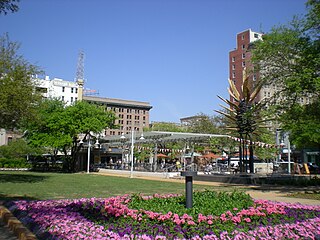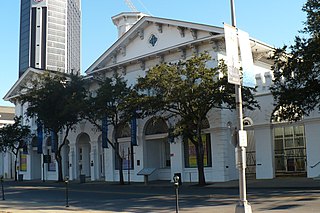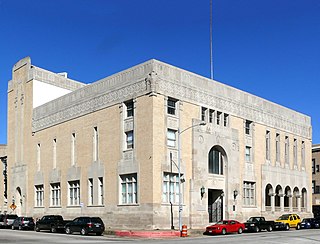
Rosenberg Library, a public library located at 2310 Sealy Street in Galveston, Texas, United States, is the oldest continuously operating library in Texas. It serves as headquarters of the Galveston County Library System, and its librarian is also the Galveston County Librarian.

The Bishop's Palace, also known as Gresham's Castle, is an ornate 19,082 square feet (1,772.8 m2) Victorian-style house, located on Broadway and 14th Street in the East End Historic District of Galveston, Texas.

Nicholas Joseph Clayton was a prominent Victorian era architect in Galveston, Texas.

The Grand 1894 Opera House in Galveston, Texas is currently operated as a not-for-profit performing arts theatre. The Romanesque Revival style Opera House is located at 2020 Post Office Street in Galveston's Historic Downtown Cultural Arts District. It was named "The Official Opera House of Texas" in 1993 by the 73rd Texas Legislature. It has a seating capacity of 1,040.

Market Square Park is a public park in Downtown Houston, Texas, United States. Originally set aside by the Houston Town Company as "Congress Square," the public square was used as a marketplace and city hall, which assumed the name, "Market Square." The City of Houston constructed four different market house/city halls, the first of which opened in 1840. The fourth was constructed in 1904. Market Square is a central feature of the Main Street/Market Square Historic District, a historic district listed on the National Register of Historic Places. The square is surrounded by a combination of nineteenth-century architecture and modern residential towers, with ground leases housing a variety of restaurants and bars.

Old City Hall, also known as the Southern Market, is a historic complex of adjoining buildings in Mobile, Alabama, that currently houses the History Museum of Mobile. The complex was built from 1855 to 1857 to serve as a city hall and as a marketplace. It was declared a National Historic Landmark in 1973, as a rare well-preserved example of a 19th-century multifunction civic and commercial building.

The Grand Galvez Resort & Spa is a historic 226-room resort hotel located in Galveston, Texas, United States that opened in 1911 as the Hotel Galvez. It was named to honor Bernardo de Gálvez, 1st Viscount of Galveston, for whom the city was named. The hotel was added to the National Register of Historic Places on April 4, 1979. It is a member of Historic Hotels of America, the official program of the National Trust for Historic Preservation.

Alfred Charles Finn was an American architect. He started in the profession with no formal training in 1904 as an apprentice for Sanguinet & Staats. He worked in their offices in Dallas, Fort Worth, and Houston. His credits during his tenure residential structures, but firm was a leader in steel-frame construction of skyscrapers.

One Moody Plaza is a 23 floor skyscraper at 1902 Market Street in Downtown Galveston, Texas, United States. The building was designed by the architectural firm of Neuhaus & Taylor. At its completion in 1972, One Moody Plaza was the tallest building in Galveston County, standing 357.6 feet tall, but was surpassed by the Palisade Palms Condominiums, built in 2008 with 27 floors and standing at a height of 381 feet. The building was listed on the National Register of Historic Places in 2021.

The United States Customs House and Court House, also known as Old Galveston Customhouse, in Galveston, Texas, is a former home of custom house, post office, and court facilities for the United States District Court for the Eastern District of Texas, and later for the United States District Court for the Southern District of Texas. Completed in 1861, the structure is now owned and operated by The Hodge Law Firm.

Grace Episcopal Church is a historic church at 1115 36th Street in Galveston, Texas. It was built in 1894 and added to the National Register in 1975.

Scottish Rite Cathedral is a historic Scottish Rite Masonic building at 2128 Church Street in Galveston, Texas.

Eugene Thomas Heiner was an American architect who designed numerous courthouses, county jails, and other public buildings in Texas. He was born in New York City, apprenticed in Chicago, and studied further in Germany. His works includes buildings listed on the U.S. National Register of Historic Places.

The E.S. Levy Building, also known as the National Hotel Building is a historic structure in Galveston, Texas.
Howard Barnstone was a Houston-based American architect. He was best known for his work with Mark Rothko on the Rothko Chapel, and for the houses and public buildings he designed with Preston M. Bolton and Gene Aubry in the 1950s and 1960s, largely in Houston and Galveston. Barnstone attended Yale College and the Yale School of Architecture, from which he received a Bachelor of Architecture in 1948. He was a professor at the University of Houston College of Architecture and Design for more than thirty years. From 1952 to 1961, Barnstone was a partner in Bolton & Barnstone, one of Houston´s most public modern architectural firms at the time; the firm became Barnstone and Aubry (1966-1970) after he partnered with Aubry, his former student. Architectural historian Stephen Fox characterized Barnstone's approach as one committed to personal vision, free inquiry, and delight over orthodoxy or conventional wisdom, resulting in diverse buildings that combined proportional grace with wit and charm, and diminutive scale with spatial expansiveness.

The Menard House, also known as The Oaks, is a historic detached-home located at 1605 Thirty-Third Street in Galveston, Texas. Built in 1838, it is the oldest surviving structure in Galveston as recently as 2014 and is on the National Register of Historic Places.The address for the home is 1604 33rd St, Galveston TX.

Eugene Edwards Aubry was an American architect, based primarily in Houston, Texas and later in Orlando, Florida. He was best known for the public buildings and houses he designed and co-designed in Houston, notably the Rice Museum at Rice University and the Alfred C. Glassell School of Art at the Museum of Fine Art Houston, the Rothko Chapel, and Wortham Center. Architecture writers credit the Art Barn's industrial aesthetic with inspiring Houston's so-called "Tin House" movement, as well adaptations by Frank Gehry. Aubry was partners with two other well-known Houston architects, Howard Barnstone and S.I. Morris, and worked on projects with Philip Johnson before starting his own firm, Aubry Architects in Sarasota, Florida in 1986. He completed the Rothko Chapel after artist Mark Rothko clashed with Johnson, who was the original architect.

Eiband's is a National Register of Historic Places-listed property at 2201 Post Office Street in Galveston, Texas.

The Model Laundry & Dye Works Building is a National Register of Historic Places-listed building located at 513−525 Rosenberg Avenue in Galveston, Texas.




















